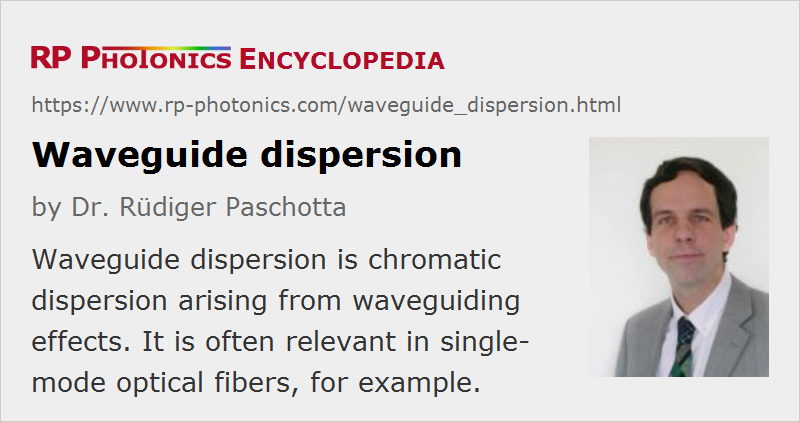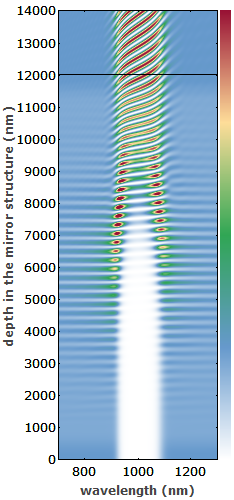Waveguide Dispersion
Definition: chromatic dispersion arising from waveguiding effects
More general term: chromatic dispersion
German: Wellenleiterdispersion
Category: fiber optics and waveguides
How to cite the article; suggest additional literature
Author: Dr. Rüdiger Paschotta
Waveguide dispersion is chromatic dispersion which arises from waveguide effects.
Generally, the phase shifts for a wave in a waveguide differ from those which the wave would experience in a homogeneous medium. It would also not be correct to assume that the propagation constant of a waveguide mode could simply be calculated as a weighted average based on a spatially varying refractive index and the mode intensity profile. Such an approach would ignore the effects of diffraction. The true phase shift per unit length (called β) at a particularly optical frequency is expressed by the imaginary part of the so-called propagation constant. For calculating β values of a waveguide, one usually requires a mode solver.
The chromatic dispersion of waveguide modes can be calculated based on frequency derivatives of the mode-dependent β values. For example, second-order dispersion, quantified as group velocity dispersion, is the second-order derivative of β with respect to angular frequency ω.
The total chromatic dispersion of a waveguide is often considered as the combination of material dispersion and waveguide dispersion. In other words, waveguide dispersion is considered as the difference between total dispersion and material dispersion – effectively a correction term introduced by waveguide effects. That, however, raises the question how material dispersion should be calculated in cases with an inhomogeneous refractive index profile – which is the case for most waveguides (e.g. optical fibers). Only in some cases, where the optical field is confined to a region with constant refractive index (e.g. by a reflecting boundary), there is an obvious answer to that. Therefore, the term waveguide dispersion should generally be used only as a qualitative term.
The origin of waveguide dispersion can be qualitatively understood by considering that a guided wave has a frequency-dependent distribution of wave vectors (k vectors), whereas a plane wave (as the reference case) has only a single wave vector, which points exactly in the propagation direction. The relevant quantity (for chromatic disperion) in a waveguide is β, the unit phase change per propagation length in the propagation direction.
Waveguide dispersion is important in waveguides with small effective mode areas. Examples are optical fibers, in particular certain photonic crystal fibers, but also other single-mode fibers as used in, e.g., optical fiber communications. Waveguide dispersion may be tailored via the fiber design to obtain the desired dispersion properties; see e.g. the article on dispersion-shifted fibers. For fibers with large mode areas, waveguide dispersion is normally negligible, and material dispersion is dominant.
Questions and Comments from Users
Here you can submit questions and comments. As far as they get accepted by the author, they will appear above this paragraph together with the author’s answer. The author will decide on acceptance based on certain criteria. Essentially, the issue must be of sufficiently broad interest.
Please do not enter personal data here; we would otherwise delete it soon. (See also our privacy declaration.) If you wish to receive personal feedback or consultancy from the author, please contact him e.g. via e-mail.
By submitting the information, you give your consent to the potential publication of your inputs on our website according to our rules. (If you later retract your consent, we will delete those inputs.) As your inputs are first reviewed by the author, they may be published with some delay.
Bibliography
| [1] | J. A. Mores Jr et al., “Efficient calculation of higher-order optical waveguide dispersion”, Opt. Express 18 (19), 19522 (2010), doi:10.1364/OE.18.019522 |
| [2] | A. W. Snyder and J. D. Love, Optical Waveguide Theory, Chapman and Hall, London (1983) |
| [3] | R. Paschotta, tutorial on "Passive Fiber Optics", Part 10: Chromatic Dispersion |
See also: waveguides, chromatic dispersion, dispersion-shifted fibers
and other articles in the category fiber optics and waveguides
 |




If you like this page, please share the link with your friends and colleagues, e.g. via social media:
These sharing buttons are implemented in a privacy-friendly way!